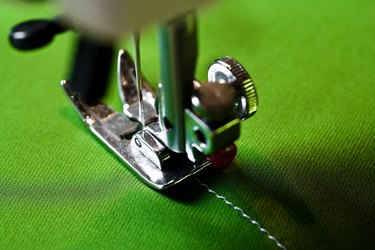
The task of a sewing machine is always to create stitches, either to decorate the fabric or to hold multiple pieces of cloth together to create a garment or accessory. The way that the sewing machine accomplishes this task determines its classification. Some classes of sewing machines have been developed to accomplish specific and narrow sets of stitches while others are more general in their uses.
Mechanical Sewing Machines
Video of the Day
Mechanical sewing machines have been around for more than a century. Early models were powered when the seamstress would pump a foot pedal or treadle. Modern machines are electrically powered. All sewing machines offer a straight stitch; some include zigzag or other specialty stitches. The manual sewing machine uses either a oscillating shuttle or a rotary stitching system.
Video of the Day
Walking Foot Sewing Machines
A walking foot can be a special sewing machine or an attachment to a mechanical sewing machine. A walking foot is used to sew heavy fabric or multiple layers of lighter weight fabric. The walking foot compresses the material as the stitch is executed. The foot then walks the fabric forward for more stitches. Walking foot sewing machines are designed for sewing heavy material, such as canvas and leather, and are often constructed with heavier components. They also use stronger needles.
Sergers
Sergers are used to apply a finished look to the edge of the sewn material. The serger cuts the material and perform an overlock stitch on the material. Sergers can use as many as eight threads in finishing an edge of a piece of fabric.
Electronic Sewing Machines
Electronic sewing machines offer a wide variety of stitches not available from a manual sewing machine. An array of buttons or digital controls determine the type of stitch the machine will execute. Many stitches are decorative and are used for embroidery type applications. Electronic sewing machines can also be used for standard stitching and mending applications.
Computer-Controlled Sewing Machines
Computer-controlled or assisted sewing machines are among the most recent additions to the sewing machine family. Computer-controlled sewing machines are commonly used for embroidery. Embroidery patterns can be developed on a computer, with the use of special software and then loaded into the sewing machine through a memory card. Computer sewing machines can also be used for standard sewing tasks, like stitching and mending.